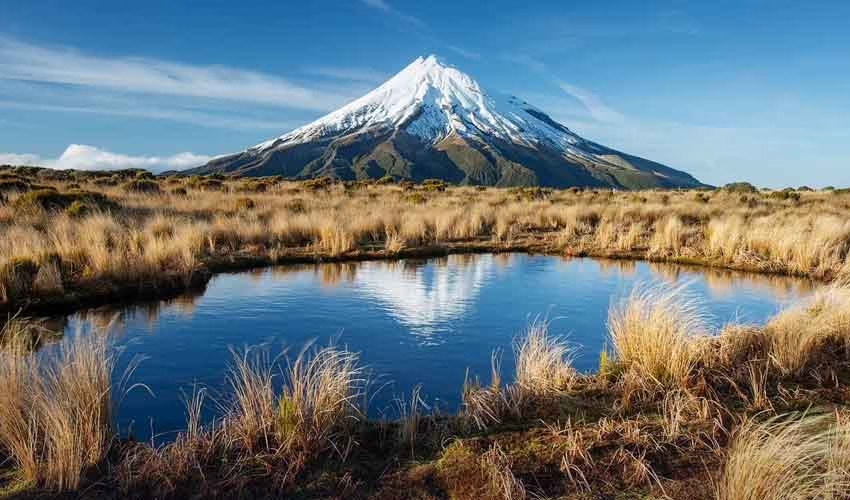New Zealand has taken another groundbreaking step in recognizing the rights of nature by granting legal personhood to Taranaki Maunga, a revered mountain on the North Island. This move acknowledges the deep spiritual and cultural connection between the Indigenous Māori people and the mountain, reinforcing New Zealand’s commitment to honoring its colonial past and Indigenous treaties.
Taranaki Maunga: A Sacred Ancestor
Taranaki Maunga, previously known as Mount Taranaki, holds significant spiritual importance for the Māori tribes of the region. They consider it a living ancestor, a source of cultural and spiritual sustenance, and a place of deep historical significance. Standing at 2,518 meters (8,261 feet), the snow-capped dormant volcano is also a popular destination for tourists, hikers, and adventure seekers.
On February 1, 2025, New Zealand’s government officially recognized the mountain as a legal person, granting it the same rights and obligations as a human being. This follows a growing global trend of recognizing natural entities as legal persons to ensure their protection and sustainability.
A Landmark Legal Recognition
This recognition is not the first of its kind in New Zealand. In 2014, Te Urewera, a large native forest, was granted personhood, followed by the Whanganui River in 2017. These legal precedents highlight New Zealand’s commitment to integrating Indigenous worldviews into its legal framework.
Taranaki Maunga’s new status as a legal entity means it will have rights, authority, obligations, and liabilities, ensuring its protection and preservation. The legal personality, named Te Kāhui Tupua, encompasses the mountain and surrounding areas, acknowledging both their physical and metaphysical elements.
Governance and Protection
A newly established organization will act as the “face and voice” of Taranaki Maunga. This body will consist of:
- Four members appointed by New Zealand’s Conservation Minister.
- Four representatives from local Māori iwi (tribes).
This governance structure ensures that both Indigenous and governmental perspectives are considered when making decisions about the mountain’s management, conservation, and accessibility.
A History of Colonial Dispossession
The recognition of Taranaki Maunga as a legal person is also an effort to rectify historical injustices. During New Zealand’s colonization in the 18th and 19th centuries, the mountain’s Indigenous name, Taranaki, was replaced with Mount Egmont by British explorer Captain James Cook. In 1865, the Crown confiscated large portions of Taranaki land, including the mountain, as punishment for Māori resistance against colonial rule. Over the next century, Māori lost governance rights over the mountain, while hunting and tourism industries thrived.
However, in the 1970s and 1980s, a strong Māori rights movement pushed for greater recognition of Indigenous culture, language, and land rights. The Treaty of Waitangi, signed in 1840 between Māori tribes and the British Crown, was revisited, leading to increased settlements and reparations. The recognition of Taranaki Maunga as a legal person is part of this ongoing process of reconciliation.
How Will Personhood Impact Taranaki Maunga?
With its new legal status, Taranaki Maunga will enjoy rights similar to those of a human being. But how exactly will this be implemented?
- Environmental Protection: The recognition ensures that the mountain’s health and welfare are prioritized. Any activities that threaten its well-being, such as forced sales or environmental degradation, can now be legally challenged.
- Conservation Efforts: Indigenous practices and conservation initiatives will be integrated to restore the mountain’s ecosystem, benefiting native wildlife and flora.
- Public Access: While the public will still have access to the mountain, its management will now be more aligned with Indigenous cultural values and environmental sustainability.
- Legal Representation: The governing body will have the power to make legal decisions on behalf of Taranaki Maunga, ensuring its interests are protected.
Māori Leaders Celebrate the Decision
Māori leaders have welcomed the legislation as a long-overdue acknowledgment of their spiritual and ancestral ties to Taranaki Maunga.
Debbie Ngarewa-Packer, co-leader of Te Pāti Māori, described the decision as a release from the shackles of injustice. She emphasized that the Māori people have always been connected to the mountain, and this legal recognition strengthens that bond.
A Global Shift Towards Nature’s Rights
New Zealand’s move aligns with a broader global trend of recognizing nature’s rights. Other countries, including Ecuador, Bolivia, and India, have granted legal personhood to rivers, forests, and other natural entities. These initiatives aim to protect ecosystems from over-exploitation and ensure Indigenous communities have a say in environmental governance.
The legal recognition of Taranaki Maunga as a person is a significant step in acknowledging Indigenous rights, rectifying historical injustices, and ensuring environmental conservation. It reflects New Zealand’s evolving approach to land management—one that integrates cultural, legal, and environmental perspectives.
With this precedent, other natural features in New Zealand and beyond may also receive similar legal protections, further advancing the global movement for environmental justice and Indigenous recognition.



